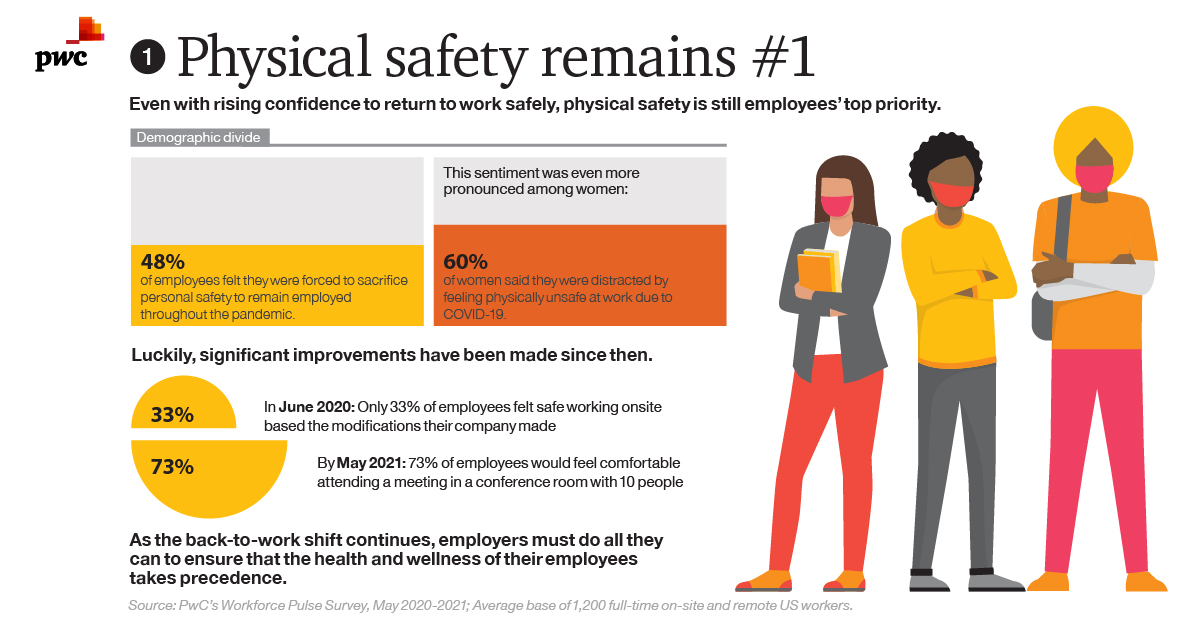Four Ways to Energize a Post-Pandemic Workforce
The following content is sponsored by PwC

Four Ways to Energize a Post-Pandemic Workforce
The pandemic has put the workforce through the wringer, and shifted priorities for both employees and employers alike.
But as the world starts to look towards future growth and economic recovery, it’s important to recognize that each segment of the workforce has their own diverse needs.
Drawing from a year-long survey of 1,000+ full-time employees, PwC highlights the four biggest back-to-work priorities and challenges that employers must address to retain and recharge the workforce. We’ll also dive into some demographic gaps that emerge.
1. Physical Safety Remains #1
Almost half (48%) of employees felt that they were forced to sacrifice personal safety in order to remain employed throughout the pandemic. Women felt these effects even more strongly—60% said that feeling physically unsafe due to COVID-19 was distracting to their work.
Luckily, things took a turn for the better over the course of the year.
- In June 2020: Only 33% of employees felt safe working on-site based on the modifications their company made
- By May 2021: 73% of employees would feel comfortable attending a 10-person meeting in a conference room
Even with rising confidence to return to work safely, employers must do all they can to put their employees’ health first and bring this share back up to 100%.
2. Mental Health on the Mind
Shared feelings of isolation during the pandemic translated into a growing call for mental health support from employees.
Yet, while 84% of CFOs thought their company had successfully addressed employee wellness, only 31% of employees felt the same. Remote workers and women felt even more disconnected:
- 27%: Remote workers
- 26%: Women aged 18-34
- 22%: Women aged 35-44
This stark difference in perceptions suggests that leaders may not be rolling out enough support for these intangible impacts of COVID-19—or they aren’t thoroughly communicating all the resources available.
3. Time Matters Most—Even Above Pay
With lines between work and play being blurred in remote working environments, employees are beginning to value their free time more than a rise in salary. In fact, 54% expressed that receiving an extra week of paid time off would enrich their life the most in 2021.
Younger generations in particular feel strongly about this flexibility. A significant share are willing to swap the opportunity for a higher pay grade for the ability to work virtually from almost anywhere:
- 45%: Gen Z
- 47%: Millennial
- 38%: Gen X
- 14%: Baby Boomers
Similar trade-offs were expressed with the offer of more non-monetary perks, such as: the opportunity to learn new skills, unlimited sick time, flexible work hours, and remote work options.
4. See Me, Hear Me
Above all, employees feel the desire to be included and their concerns heard. Only 35% think that their company has effectively created an inclusive work environment for them and their colleagues, and this gap deepens with specific concerns around workload.
| Women (Aged 35-44) | All surveyed employees | |
|---|---|---|
| % that say an unmanageable workload impacts their productivity | 65% | 57% |
| % that feel unable to ask for help managing work stress | 70% | 52% |
Women especially face extra barriers compared to their counterparts, and seek more personalized support for their workplace struggles.
Working Together To Get Back to Normal
The pandemic turned the world upside down. This also means that “normal” no longer resembles what it used to be, and the days of one-size-fits-all solutions are over.
To attract the brightest talent and drive growth, employers must understand what the diverse workforce needs—and step up to empower them.
Find out how PwC is reimagining work in 2021 and beyond.
-

 Sponsored3 years ago
Sponsored3 years agoMore Than Precious: Silver’s Role in the New Energy Era (Part 3 of 3)
Long known as a precious metal, silver in solar and EV technologies will redefine its role and importance to a greener economy.
-

 Sponsored7 years ago
Sponsored7 years agoThe History and Evolution of the Video Games Market
Everything from Pong to the rise of mobile gaming and AR/VR. Learn about the $100 billion video games market in this giant infographic.
-

 Sponsored8 years ago
Sponsored8 years agoThe Extraordinary Raw Materials in an iPhone 6s
Over 700 million iPhones have now been sold, but the iPhone would not exist if it were not for the raw materials that make the technology...
-

 Sponsored8 years ago
Sponsored8 years agoThe Industrial Internet, and How It’s Revolutionizing Mining
The convergence of the global industrial sector with big data and the internet of things, or the Industrial Internet, will revolutionize how mining works.


